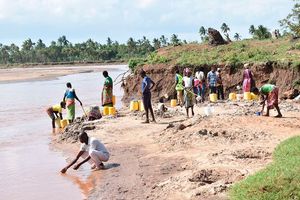How bilharzia has turned our lives upside down

Dominic Oreyo during the interview in Ombaka Village, Nyando Sub-county in Kisumu. He was among the fishermen who were diagnosed with bilharzia
What you need to know:
- Kisumu County treats 1,200 to 1,500 cases of bilharzia and 1,000 to 1,500 cases of snake bites every year.
- The cases of bilharzia are a result of compromised sanitation due to time-to-time floods in Nyando Sub-county.
Rising water levels in Lake Victoria that have left land submerged, time-to-time flooding and extremely dry seasons are just some of the threats to food security in Nyando, Kisumu County.
To adjust to the harsh conditions, many residents in Ombaka, Nyando Sub-county resorted to fishing in order to fend for their families.
But now their new source of livelihood is facing a major threat due to bilharzia outbreak; with more than 20 confirmed cases among fishermen.
Schistosomiasis, also known as bilharzia, categorised as a disease of poverty, is an infection caused by a parasitic worm that leads to chronic ill-health. Infection is acquired when people come into contact with fresh water infested with the larval forms (cercariae) of parasitic blood flukes, known as schistosomes.
According to the World Health Organization (WHO), bilharzia affects almost 240 million people worldwide. Biomed Central’s tropical medicine department’s data from 2019 show that about six million Kenyans are infected, and another 15 million are at risk of schistosomiasis
For the last two years, the once-active fishermen of Nyando have now been forced to abandon their boats and nets as most of them have had the symptoms of the water-borne disease since 2019 after an outbreak of the disease, which has rendered them weak and sickly, unable to provide for their families.
Mr George Otieno, a resident of Ombaka, says he has been struggling with the waterborne disease for the last three years. He is yet to recover despite seeking treatment. The 37-year-old says he had sought treatment in a number of health facilities prior to his diagnosis.
“I started feeling sickly in 2019. My stomach would not stop rumbling and my entire body was itchy, especially at night,” he says.
Other symptoms included a swollen stomach, fatigue, traces of blood in urine and faeces, sleepless nights and lack of appetite.
At first, he had dismissed the symptoms for any other normal stomach ache and taken traditional herbs instead of visiting a health centre.
This went on until April 2021 when he decided to visit Jaramogi Oginga Odinga Teaching and Referral Hospital (JOOTRH) . Then, he was weak and could not continue fishing. “I had lost a lot of weight and could barely eat anything,” says George, adding that he was also forced to abandon fishing due to general body weakness.
He explains that he went through a number of tests to find out the condition of his stomach, kidney, and heart and was later given a drug prescription.
His stomach, however, continued to swell; with his health deteriorating with each passing day. Without a source of income, he says he was unable to seek further attention and solely depended on painkillers. “I have been unable to visit any healthy facility since then due to lack of funds. I had to sell one of my animals to settle my hospital bills when I first sought health services. My family has, however, been left with nothing. Our remaining source of income, a two-acre piece of land, is still submerged in the lake,” he explains.
Since then, George shares that he has been too weak to carry out any duty. He spends his days seated under a shade while on most occasions he goes without food when his wife is unable to provide.
“The fact that I can barely provide for my family has left me worried, for how long am I going to depend on my wife for food and support, a man’s pride is all based on his ability to provide,” he says.
Dominic Okeyo, another resident, says he has been living with similar symptoms for the last two years. Just like Gorge, he had also started displaying similar symptoms in 2020 but dismissed them until his health started deteriorating in 2021. “I first visited Ahero Sub-county Hospital, where a sample of my urine and faeces were collected for a laboratory test, “he says.
He also visited JOOTRH for a scan, which revealed that his liver had been bleeding while his blood supply had also dropped drastically. He was placed on medication after a blood transfusion but his condition kept deteriorating.
“When I started feeling sick, we had just vacated our homes due to floods, this made a number of the infected fishermen think the infection could have been a result of the dirty water,” he explains.
The father of three is yet to get back on his feet due to general body weakness while his stomach has also remained swollen.
In January, Kisumu County government health department took a number of samples of urine and faecal matter for tests; with the results revealing that they were suffering from bilharzia, and 20 patients were placed on treatment.
Health Executive Gregory Ganda said bilharzia is the leading neglected tropical disease (NTD) in Kisumu followed by snake bites.
According to Mr Ganda, the county treats 1,200 to 1,500 cases of bilharzia and 1,000 to 1,500 cases of snake bites every year.
He reported that the treatment exercise was, however, affected by last year’s general election ,which saw most of the residents miss out on treatment.
“Every year, we always treat 1,200 to 1,500 cases of schistosomiasis, last year we only treated 800, which could have resulted in the outbreak. He shared that the cases of bilharzia are a result of compromised sanitation due to time-to-time floods in Nyando Sub-county.
“Nyando has often experienced lots of flooding and therefore, sanitary facilities are difficult to maintain with most of the latrines collapsing, “said Dr Ganda.
He added: “In the absence of sanitary facilities, the residents often resort to open defecation which is one of the risk factors for schistosomiasis,”.
He said that the remedy to the outbreak is through investing more in hygiene and sanitation.
The head division of water-borne and NTD Dr Wycliffe Omondi said they are also working on awareness creation to ensure the residents are informed on the diseases and how to get treatment on time.
“We are on a mission to eradicate river blindness and sleeping sickness by 2025 after successfully eradicating guinea worm in 2018,” he said.





